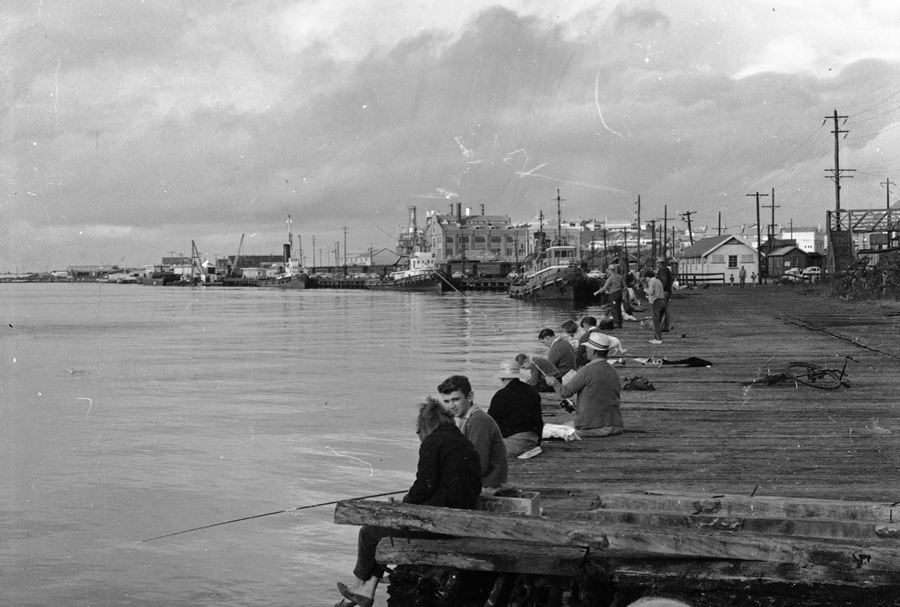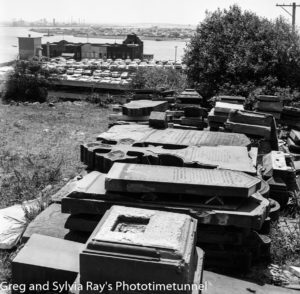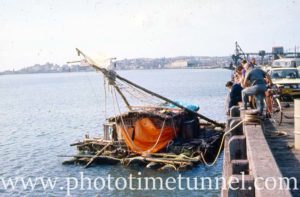Sometimes I think collecting old photographic images is a little like fishing. There’s a lot of waiting and hoping, a lot of lines cast to no avail, a lot of hauling in tiddlers of minor interest and, very occasionally, the excitement of landing something really extraordinary.
There are also the ones that get away.
Like the time I was sitting in a person’s lounge room, perusing some nice old postcards they were selling, when I noticed a plastic container full of old photographic negatives on a chair opposite. Seeing me look in that direction the person asked me if I was interested in negatives.
As you might imagine (if you know me) I waxed lyrical on my passion for old negatives.
“Well, you can have those for nothing,” they said, before adding the almost inevitable: “It’s a pity you didn’t call in last week. I’ve thrown away five times that amount since last Saturday.”
Like most collections of negatives or, indeed, photographs, that container held mostly dross but also a handful of real gems. And of course, I will always wonder what treasures might have been among the pile that went to landfill.
Such tales have become a matter of course for me.
A friend in Maitland loves to tell me of the time he was working at the local public hospital and noticed a large number of boxes of glass plate negatives in a store-room. He had a quick look at a few and particularly noted images of nurses apparently dealing with victims of the 1919 influenza pandemic.
He was due to go on holiday but resolved to ask about these negatives as soon he returned in a couple of weeks. It goes without saying that in the short interval before his return these dusty old boxes, left so long untouched in a remote store room, were thrown away as part of a general clean-up.
Skip-diving
Another friend received some wonderful negatives from a person who salvaged them from a skip bin. Apparently there were many, many more, but the skip-diver only grabbed what was easy to reach. I don’t blame them, but had I known in time I’d have donned my flippers and plunged into the bin head-first.
A descendant of prolific and talented photographer William Weston, active in the Hunter and elsewhere in the early 1900s, told me the awful story of the fate of William’s glass negatives after his death. Dawn Weston told me that William’s wife – never happy about her husband’s expensive and time-consuming hobby – took the opportunity of his demise to carry his negatives, box by box, out to a cast-iron bath in a paddock where she smashed them into fragments. A rushed intervention by horrified family members rescued only a tiny fraction of William’s immense output.
It seems that a great many families of photographers have a disregard or even a distaste for these materials, stacked and stored in sheds and makeshift dark-rooms, and in many cases they wind up, after the death of the owners and creators, bundled into crates in dank sub-floor cavities at the whim of rising damp, dust, vermin and ignorant intruders.
Antique dealers from whom I sometimes manage to buy interesting material also delight in regaling me with stories of terrible destruction of treasure-troves of wonderful old negatives and similar material. Do they know how much it hurts me to hear these tales? I suspect they do, and revel in the pain they inflict.
Fairfax horror story
One story that makes me feel quite ill involves Australia’s Fairfax media organisation, which used to own The Newcastle Herald, the newspaper that employed me for a few decades. Apparently weary of owning a vast and precious library of magnificent photographic material, Fairfax struck a deal with a bloke in Little Rock, Arkansas in the far-off USA. As the story came to me, he paid $250,000 and got the lot on the understanding that he’d scan it all, send back digital copies and then sell the originals on his own account. I don’t need to tell you that I’d have mortgaged my house and hired full-time staff to do that job for Fairfax. Anyway, the bloke in Little Rock went broke and receivers took over the collection. Some of it has found its way back to Australian libraries etc, but what a roundabout route!
There are similarities, I guess, to the story of what we call our “Ken Magor collection” of negatives. This was a collection of material previously owned by Newcastle fireman and transport enthusiast Ken Magor, which we bought at auction in 2010. It turned out that a portion of this big collection had come from The Newcastle Herald decades before, when the newspaper had decided to downsize its library. When I worked at the paper I was often told of this downsizing event and assured that the discarded material was irrevocably lost, so it was a huge surprise to accidentally recover a portion of it. It was this material that set us to publishing books.
This surprising discovery somewhat echoed the earlier unearthing of the amazing collection of glass negatives taken in the late 1800s and early 1900s by prolific photographer Ralph Snowball. The Snowball family – luckily for Newcastle – was aware of this long-stored trove and brought it to the attention of local history enthusiasts Bert Lovett and Norm Barney. Some of this collection now resides with Newcastle Region Library, while Norm’s wife Daphne handed another portion to the archives of the University of Newcastle.
Norm Barney also had a hand in ensuring the tremendous multi-generational archive of Sydney-based photographer Sam Hood made its way to the State Library of NSW. A significant portion of this material is directly relevant to Newcastle.
Since that time important collection of photographs and negatives have appeared with encouraging regularity. Ann Hudson, for example, shared with us the wonderful work of William Fraser, preserved on glass plate negatives.
Found under the house
An important collection of glass negatives – some of it sadly damp-affected – was found under a house at Kurri Kurri. It proved to be some of the work of highly regarded Coalfields photographer Alexander Galloway.
On and on it goes, and one of the best things about this is that, as the stories become widely known, awareness of the potential importance and value of such collections grows, making it a little less likely that people will be as careless in future as others were in the past.
Of course, this same discussion can be expanded beyond our little city and valley.
Across Australia and the world remarkable collections of photographic material are always turning up, to the delight of history lovers.
Keast Burke’s discovery of the wonderful Holtermann collection is one example. The finding of the huge archive of Irish Jesuit priest Frank Browne is another. The strange story of New York photographer Vivian Maier is yet another.
Stories like these keep me keen, I must say, as do the occasional contacts from people who invite me to view collections of photos, postcards, negatives and the like. Sometimes such contacts lead to the discovery of just one really remarkable item. Sometimes they lead to stories and greater collections that send me down rabbit-holes for months on end.
Which is good because then I’m distracted from brooding over the ones that got away.



